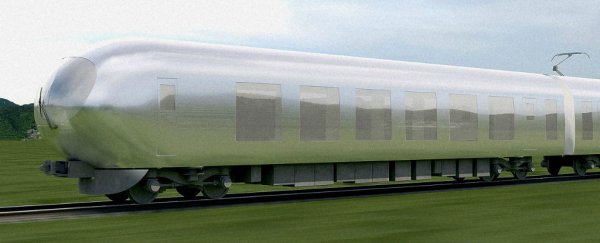If anyone's going to be dreaming up the outlandish trains of the future, it's Japan. It's already mastered the levitating bullet train, which has been ferrying its passengers across the country at speeds of up to 580 km/hour for the past two years, and now Seibu Railway Co. wants to build a train that's virtually invisible to onlookers.
Designed by architect Kazuyo Sejima from the Japanese firm Sanaa, who recently received a Pritzker Prize - the Nobel Prize of architecture - the train won't be completely invisible (obviously), but super-reflective. Basically, it blends into its surroundings by reflecting them off its pristine mirrored surfaces.
What makes this project a bit more promising than some of the ambitious things architects have been coming up with recently is the fact that the design can be applied to existing trains.
Seibu Railway Co. has given Sejima permission to redesign the exterior and interior of its Red Arrow express commuter train, to commemorate its 100th anniversary.
Expected to hit the tracks some time in 2018, the invisible express will cover over 178 km (111 miles) throughout Japan.
"The limited express travels in a variety of different sceneries, from the mountains of Chichibu to the middle of Tokyo, and I thought it would be good if the train could gently co-exist with this variety of scenery," Sejima told the press last week.
Unfortunately, not a whole lot has been made public about the forthcoming design - probably because you don't tell the world about how to build a semi-invisible train before building one for yourself. But according to Dezeen magazine, its current exterior will be replaced with semi-transparent and mirrored panels, and its boxy shape moulded into a silver bullet.
"An initial rendering shows a semi-reflective surface covering the exterior of the train - something which [Sejima] claimed had 'never been seen before now'," Dezeen reports.

If invisible vehicles sound like a pretty good idea to you - and every cat, squirrel, raccoon, and ill-fated train set that ever found itself under the wheels of a parked car that's suddenly no longer parked - Land Rover may or may not be working on a car with a transparent hood.
First unveiled at the 2014 New York International Auto Show, the technology, dubbed the 'transparent bonnet' basically applies a cloaking device to the front of your car, so you can see what's going on in front of you, below the wheels.
As A.J. McCarthy reported for Slate, while invisibility cloaks and their ilk have been pretty disappointing so far, this technology achieves 'invisibility' in an entirely different way:
"While we're on the record as being skeptical about the viability of invisibility cloaks and other sci-fi staples of that ilk, this is a different thing entirely: Land Rover is merely mimicking the appearance of transparency.
Using cameras mounted in the grill, the view from underneath the hood is simply relayed back to the heads-up display and projected onto the windshield, thereby giving drivers an unparalleled look at the road between their wheels."
Check out the video below to see what it would look like from a driver's point-of-view. Again, we have no idea if Land Rover is actually going to build something like this, or if it was just a concept like this sick Batmobile and hoverboard to drum up publicity for its less-exciting, non-invisible cars.
But one thing's for sure - if the cities of the world get their way, we're going to be living in far less car-friendly environments in the future. So maybe the only way you're going to hold onto your own personal vehicle is get a degree in engineering and figure out how to 'smoke, mirrors, and cameras' it up so the authorities don't catch you. Make it emissions-free, and we won't tell.

